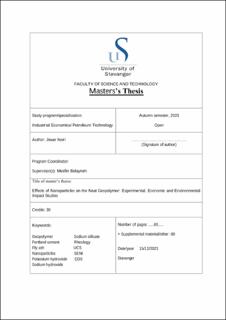| dc.description.abstract | In the oil and gas industry, cement is used for well construction and plug abandonment operations acting as a barrier element. According to NORSOK D-10, the well should be designed to control undesired flow from the reservoir to the surface. However, well integrity survey studies conducted on the North Sea production and injection wells have shown that about 11% of integrity failures are related to cement. The survey result indicated that the oil well cement does not satisfy the property requirements set by the NORSOK D-10 standard.
To ensure long-term integrity, the oil and gas industry is searching for alternative materials for plug and abandonment operations. Geopolymer is one of the alternatives in focus. Several investigators have conducted experimental studies on the geopolymers and the effect of nanoparticles on geopolymers. Results have shown the potential application of geopolymer as an alternative material to cement. However, extensive research should be performed to qualify geopolymer as a barrier element.
In this thesis, the effect of CaCO3 and Al2O3 nanoparticles on neat geopolymer has been studied compared with G-class Portland cement. Furthermore, the economic and environmental aspects of these materials have been assessed.
Results showed that:
• After 1-day curing, cement is stronger than the geopolymers with and without nanoparticles. However, after 7 days of curing, the geopolymers showed a higher strength than the cement.
• In terms of environmental issues, geopolymers are environmentally friendly than the cement due to less CO2 emission.
• In terms of economic evaluation, the reviewed analysis result showed that geopolymer concrete costs are over three times higher than cement based concrete. This suggests future research of developing a cost-effective geopolymer.
The results presented in this thesis are valid for the considered neat geopolymer, curing time, temperature, and pressure. Therefore, by changing curing conditions and the geopolymer’s composition, one may achieve different results. | |
